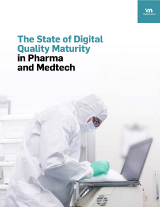
GxP Lifeline
Benefits of Embracing Digitalization in Quality Management

Digitalization in quality management entails the use of digital technologies to improve the efficiency, effectiveness, and transparency of the processes that contribute to the overall quality management system (QMS). This can be done by automating tasks, streamlining workflows, and providing real-time data insights.
Advantages of Digital Quality Management System
There are many benefits of implementing a digital QMS solution, including:
Greater Efficiency
Digital technologies are essential to automate many quality management tasks that are typically performed manually, such as document control, data entry, and reporting. An electronic quality management system (eQMS) can free up time for employees to focus on more strategic activities.
Optimized Effectiveness
Digital technologies improve eQMS effectiveness by providing real-time data insights and enabling better decision-making. This can help organizations identify and prevent problems earlier, leading to improved product quality and customer satisfaction.
Enhanced Transparency
Digital QMS processes are by nature more transparent and provide easy access to data and documentation. This can help organizations build trust with customers and other stakeholders.
There are several digital technologies that enable organizations to take a holistic, integrative approach to digital QMS, including:
- ERP Systems: Enterprise resource planning systems can be used to automate many core business processes and can be integrated with a digital QMS.
- Electronic Document Management Systems: An EDMS can be used to store, track, and manage all the documentation related to eQMS.
- Data Analytics Tools: Data analytics tools can be used to analyze data from eQMS processes to identify trends and patterns.
- QMS Software: A digital QMS solution can be used to automate tasks, streamline workflows, and provide real-time data insights.
Digitalization in quality management is a continuous process, as new technologies are constantly emerging. By embracing digital technologies, organizations can improve the efficiency, effectiveness, and transparency of their eQMS processes, leading to better product quality and customer satisfaction.
3 Innovations in Digital Technology that Streamline Quality Management
1. Cloud eQMS Deployment and Use
A cloud-based QMS allows organizations to access their QMS data and documentation from anywhere, at any time. This can help improve efficiency and collaboration.
2. Data Analytics Tools
Data analytics can be used to identify trends and patterns in digital QMS data. This information can be used to improve processes and make better decisions.
3. Artificial Intelligence (AI)
Modern AI applications can be used to automate tasks, such as document review and root cause analysis. This can free up time for employees to focus on more strategic activities.
How to Build Quality Into the Product
Quality should be a top priority throughout the product development and manufacturing process. It is not enough to rely on audits and validations to ensure quality, as these activities can only identify problems after they have occurred. Instead, quality should be built into the product from the beginning by following sound processes and procedures.
There are several ways to build quality into a product. One way is to use quality by design (QbD) principles. QbD is a systematic approach to product development that focuses on understanding the critical quality attributes (CQAs) of a product and then designing the product and its manufacturing process to ensure that these CQAs are met.
Another way to build quality in a product is to use robust design (RD). RD is a method of designing products that are insensitive to variation in the manufacturing process. This is done by identifying the key process parameters (KPPs) that have the greatest impact on the product's CQAs and then designing the process to control these parameters within a specified range.
By following these and other quality-focused practices, organizations can build quality into their products and reduce the risk of defects and recalls.
Conclusion
When considering that quality must be built into the product, it becomes clear that quality is not a destination; it is a journey. It is important to continuously strive to improve quality, even after a product has been released to the market.
Quality is everyone's responsibility. Everyone in an organization, from the CEO to the front-line employee, has a role to play in ensuring quality.
Quality is not about perfection. It is about meeting the customer's expectations.
Free Resource

Enjoying this blog? Learn More.
The State of Digital Quality Maturity in Pharma and Medtech
Download Now